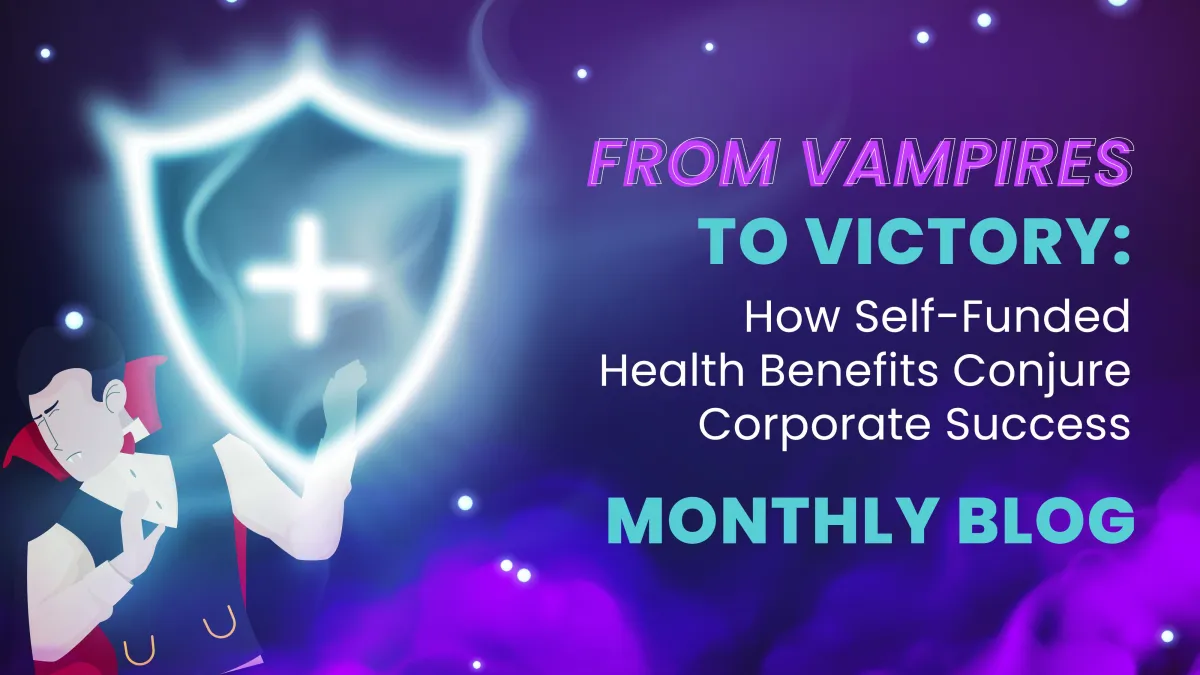WELCOME TO THB BLOG

From Vampires to Victory: How Self-Funded Health Benefits Conjure Corporate Success
Misaligned incentives bewitch 🧙🏽 traditional health insurance like blood-sucking vampires 🧛🏽♂️ draining employers' budgets to feed shareholder's profits.

Escape means transforming your health benefits through self-funding.
Did that send a chill down your spine?
Navigating the self-funded health benefits landscape may look like hiking through a cloudy mist on a moonlit night in a haunted forest.
Fear not — today, we're lifting the fog for employers prioritizing growth and innovation who know change is necessary to succeed.
The fear of the unknown creeps up on everyone at some point, especially on new adventures.
😨 Remember how eerie it felt to buy your first car?
😱 Or the gripping terror of signing your first mortgage?
Then, like the thrill and relief of surviving a haunted house, you surface from the experience thinking, "That wasn't as bad as I thought it would be."
The same holds for self-funding your health plan. At first, it may feel like stepping into Dracula's castle, but tried and true Transparent Health Benefits illuminate the path to victory, making self-funding a treat, not a trick.
Happy Halloween! 🎃 This month, we're conjuring up your courage to self-fund your health plan as we confront these three (3) goodies:
1. Thriller: What's lurking around the self-funded corner?
2. Ghostbusters: Extinguishing four (4) common myths about self-funding your health benefits
3. Trick or Treat: Unwrapping the BUCAHs
If a self-funded health insurance model has you more spooked than a vampire 🧛🏽 ♂️ at a garlic 🧄 festival, get ready to brush away the cobwebs of confusion.
You'll have greater clarity on how to self-fund your health plan while we dispel the common misconceptions surrounding it.
1. Thriller: What's lurking around the self-funded corner?

No matter your opinion of him, Mark Zuckerberg, co-founder of Facebook, spoke the truth when he said, "The biggest risk is not taking any risk...In a world that's changing quickly, the only strategy guaranteed to fail is not taking risks."
Change and uncertainty can be unnerving, but apprehension dissolves as knowledge empowers you to take the calculated risks necessary for success.
Employers who want affordable, high-quality health benefits need control — every advantage of self-funded employer-sponsored healthcare hinges on the control you gain by the transition — no more one-size-fits-all, bundled health plans.
Self-funding grants you the power to tailor your health plan to the unique needs of your member population.
In return, you enjoy:
✔️ Improved workforce health
✔️ Increased worker productivity
✔️ Reduced absenteeism
✔️ Better talent retention and acquisition
✔️ Reduced healthcare waste, fraud, and abuse
✔️ Cost-effective allocation of resources
These benefits produce happier, healthier employees and cost-effective healthcare.
You achieve these benefits with the Four Pillars of Transparent Health Benefits((THB) that integrate quality-boosting, cost-saving strategies with aligned incentives that optimize self-funded health benefits:
Pillar #1: Utilization Management
Your power lies in impacting healthcare before it happens. A knee replacement from Provider A isn't equivalent to a knee replacement from Provider B.
Cost and quality vary wildly by care location.
Proactive advocacy reduces the quantity and severity of incoming claims. When you incentivize members to allow patient advocates to steer them to high-value providers, they get better care at a better price.
Pillar #2: Alternative Reimbursement
Alternative reimbursement entails direct contracting with providers based on a pre-negotiated compensation model, including capitation, reference-based, and bundled pricing. These strategies increase cost transparency, eliminate billing headaches, motivate providers to produce the best possible outcomes for every member and reduce the administrative burden of filing claims. These innovative compensation structures foster a mutually beneficial scenario where providers, employers, and employees come out ahead.
Pillar #3: Prescription Drug Optimization
Prescription drug costs typically account for 20%-25% of an employer's healthcare spending. A large portion of that is unnecessary.
Self-funded plans produce substantial savings — up to 867%.
Optimization strategies focus on specialty drug utilization, generics, international pharmacy programs (IPP), and leveraging manufacturer assistance programs (MAPs).
Pillar #4: Enhanced Access to Care
Members' health snowballs downhill 📉 when their access to care is challenging, inconvenient, or unaffordable. Low engagement with the health plan costs you a fortune as little problems become monstrous.
The savings realized by self-funding strip away the barriers to care. Deploying access solutions like virtual care, near-site and on-site clinics, and advanced primary care reduces time off the clock, transportation, and childcare expenses. Streamlining access for members lowers care gaps, improves outcomes, and reduces the employer's healthcare spend.
These four pillars guide your journey through self-funding. Along the way, it's important to bust some myths that hold back innovative employers seeking savings without sacrificing high-quality healthcare.
2. Ghostbusters: Extinguishing four (4) common myths about self-funding your health benefits

Self-funding is more common than you think: 61% percent of covered workers have a wholly or partially self-funded plan.
Loads of employers elect to self-fund to pay less for better benefits, and it's not just for jumbo organizations. Smaller employers relish massive gains in the self-funding space, too.
It's time to debunk the myths that make employers shudder.
Myth #1: Employees don't like technology.
The research doesn't support this one.
86% of over 4,000 surveyed patients revealed they're comfortable with healthcare technology tools.2 Another poll of 2,000 patients showed that roughly 4 in 5 Americans prefer using technology to manage their healthcare experience.3 In fact, 61% of healthcare consumers want their experience to mirror the convenience of apps like Amazon and Uber.
The truth: Members want more technology.
Myth #2: Employee education and communication can't improve utilization.
Members want convenient and affordable healthcare — that's it.
Their struggle lies in understanding how the system works and navigating through it effectively. We must maximize savings without sacrificing quality; member education must be ongoing, multimodal (email, text, and video), multilingual, and data-driven to boost utilization and close care gaps.
Remember, your members are natural shoppers who use data daily to make purchases. Whether ordering a new salad spinner or buying a car, they look at reviews, specifications, benefits, and price data. Provide as much data as possible so members can make informed healthcare decisions and source high-value providers. Ensure they understand the incentives available to motivate them to use high-quality, low-cost providers.
Member education and communication dispel fears of pursuing care. Only in healthcare do we learn the price after we receive the service. It only takes one horrific mailbox experience — the kind where you swipe open an envelope to get slapped in the face with an astronomical medical bill. Follow that trauma with the hassle of disputing the charges, to which your employees respond by swearing off all but life-or-death healthcare. Members’ education and empowerment calm these fears as they learn to trust and use the benefits you provide — that takes time and communication — but it's critical to cutting your costs.
Myth #3: Employees hate change.
What's in it for them?
Your employees are more than happy to make changes when they understand what's in it for them.
Like trick-or-treaters on the hunt for the house handing out full-sized candy 🍭, members need to see how they benefit from the changes. Hence, the importance of member education and communication.
41% of healthcare consumers in the U.S. have medical debt.4 Show them how to access care for no or low cost, and they'll show up all. day. long.
Employees happily switch to a higher-value doctor when a patient advocate shows them their current provider's low-quality scores, and 35% of patients would switch providers in exchange for same-day appointments for non-routine issues.
Up to 70% of surveyed patients consider switching providers for more convenient services and locations, and 59% say convenience is more important than having a designated provider.
Integrate a consistent, frequent member education program that shows employees what's in it for them, and you'll see the savings start pouring in.
Myth #4: A catastrophic claim could wipe us out.
If your organization got fully insured in the past, your carrier included stop loss insurance in your bundled premium for this exact reason — they call it by a different name: reinsurance.
No one enjoys medical billing surprises. 😳 Not you, not the carriers, and indeed not the members.
Stop-loss insurance is a risk management tool designed to protect self-funded employers like you from substantial losses that may arise from catastrophic or unpredictable health claims.
It limits your financial exposure by reimbursing claims exceeding predetermined thresholds. During the Request For Proposal (RFP) process, claims data trends supplied to the stop-loss carrier determine the thresholds. In partnership with your adviser, you submit supporting documentation, underwriters review the data, and then they submit a bid for your business. Before accepting a bid for stop-loss insurance, negotiations about policy enhancements occur to address an employer's unique needs.
Then, enrollment begins, and you're protected! 🛡️
3. Trick or Treat: Unwrapping the BUCAHs

The BUCAHs [Blue Cross Blue Shield, UnitedHealth Group, Cigna, Aetna (CVS Health), and Humana] get publicly traded mega-carriers expected to produce profits for their shareholders quarter after quarter. 👎🏽 These conflicts with any allegiance to you as the client.
Their paychecks are dependent on your premium.
Federal regulations limit how much of each premium dollar insurance companies can allocate to administrative costs, marketing, and profits — $20 of every $100 at most.
The math only shakes out one way: The more you pay, the bigger the BUCAH profits.
The status quo — traditional health insurance — means employers accept annual increases, shift costs to the employees, and powerlessly hope for a better next year, which never happens.
Employees' real wages decline 📉 until they get fed up and resign to work for a company with better benefits.
The big three (3) pharmacy benefits managers (PBMs) are CVS Health (CareMark), Express Scripts (Cigna), and OptumRx (UnitedHealth Group). They, too, are publicly traded — accountable to shareholders, not you as the client.
Aligning with insurers and PBMs under this conflict of interest prevents you from getting the desired results.
Something must change — Self-funding kicks the status quo to the curb.
Fully insuring with the BUCAHs equates to pounding the easy button 🔴 once a year. They bundle your administrative services, stop loss insurance, network partners, and a PBM together for you.
Convenience comes with a price — you get hands-free health benefits in exchange for higher renewals, premium taxes, and auto-adjudication processes that miss billing errors, leading to fraud, waste, and abuse. And when your organization has a lower claims year, the carrier gets to keep the surplus, not you. 🤯
Alternatively, unbundling with a skilled self-funded adviser means picking the best-in-class partners: an independent third-party administrator (TPA), PBM, stop loss carrier, and network. You enjoy access to your plan data, which fuels informed, data-driven, cost-containment plan design decisions and goals. It's a hands-on approach, but as the savings roll in, you can deploy those funds to higher wages, expanding benefits, or boosting innovation. 📉
It means you do only some of it. Your properly incentivized adviser facilitates and executes these decisions to build a strategic health benefits plan that aligns with your goals and values.
Adviser
Your adviser's compensation should be ghost-like 👻 — transparent.
In traditional health insurance, the carrier pays your adviser a commission based on a percentage of your renewal and often a bonus for retaining you as a client for another year. There's no incentive for them to save you a penny.
Instead, pay a self-funding adviser a flat fee with a percentage-of-savings bonus based on what their strategies save you. Now they're working hard for you.
To get stellar self-funded health benefits, hire an adviser who:
· Is incentivized to prioritize your savings and quality goals.
· Believes in compensation transparency.
· Supports your role as a fiduciary (responsible party) of the plan funds.
· Relishes innovative, creative solutions to keep more savings coming over the years.
· Is ready, willing, and able to connect you with like-minded service providers.
Hitching your wagon to the right professional is a critical first step to self-funding.
Third-party Administrator
Independent TPA partners with you and your adviser to strategically execute the day-to-day function of your health plan, including:
✔️ Enrollment
✔️ Eligibility verification
✔️ Claims processing
✔️ Direct contracting
✔️ Customer service
✔️ Establishing a direct primary care
You pay the TPA — they work for you. Your goals are their goals.
Pharmacy Benefits Manager
Pharmacy is a colossal opportunity for savings.
Transparency is vital in the pharmacy realm. With an independent PBM, you'll know who's paying how much and confirm the markups are reasonable.
You'll be free to control and diverge from the formulary as needed to reduce costs without sacrificing quality, which demands alternative drug-sourcing strategies like manufacturer assistance programs and international pharmacy programs.
The PBM handles all things prescription drug benefits, including:
✔️ Processing prescription drug claims
✔️ Negotiating discounts with drug manufacturers and pharmacies
✔️ Overseeing drug utilization
✔️ Establishing mail-order pharmacy services
✔️ Connect members with MAPs
✔️ Execute IPP opportunities
✔️ Manage specialty pharmacy savings
Whoever controls the formulary and enjoys the pharmaceutical manufacturer rebates wins financially every time — make sure that's you.
Recruiting a team of experts shelters and directs you through the new territory as you reject the status quo to gain the control you need to supply high-quality, affordable benefits to your employees.
Self-funded health benefits demystified.
Self-funding isn't so spooky after all. 👻
The intimidation of it dissolves in the cauldron of education, empowerment, and control.
You're not tiptoeing through a haunted house — you and your benefits team hold the keys to every creaky door — therein lies the power to customize your health plan to your member population's health profile and celebrate the physical, emotional, and financial rewards.
Implementing the Four Pillars of Transparent Health Benefits, utilization management, alternative reimbursement strategies, prescription drug optimization, and enhancing member access to care wards of double-digit annual renewal increases.
Premiums and employee out-of-pocket expenses decline, making their real wages go up. 👍🏽
Self-funding isn't casting off all safeguards either — it's shielding your organization with experts who have your back and a vested interest in your success.
Skillfully deployed, self-funded health benefits illuminate the dark corners of the healthcare system — banishing fear and uncertainty along the path to high-value care — the rewards are thrilling! 🥳
Sources:
1https://www.kff.org/report-section/2018-employer-health-benefits-survey-section-10-plan-funding/
2https://www.phreesia.com/help-patients-feel-more-comfortable-with-healthcare-technology/
3https://patientengagementhit.com/news/convenience-technology-use-can-boost-patient-satisfaction
4https://www.kff.org/report-section/kff-health-care-debt-survey-main-findings/





